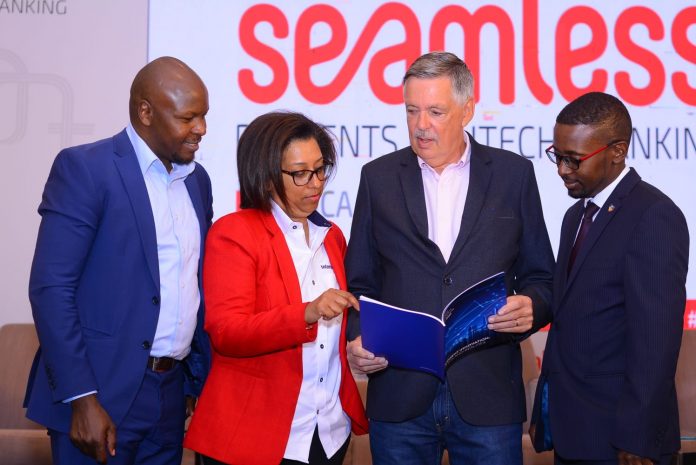Today in Nairobi, Interswitch Group formally unveiled the 2022 Payments Innovation Jury Report, which was also supported by The World Bank and Global Processing Services (GPS).
The report titled: “Payment Innovation: Myths and Realities”, comes as part of the series of the which reveals some surprising insights from senior decision makers across the industry, and the 2022 report, which coincides with Interswitch’s 20th anniversary commemoration, explores several key areas where payment innovation is currently focused, including A2A payments and BNPL, what actually drives innovation, and which areas of innovation are most overhyped, amongst other incisive global payment themes.
The 2022 Payments Innovation Jury whose expert insights and perspectives essentially drove the report, was made up of 79 senior payments leaders across 30 different markets.
To give a full, 360- degree picture, a significant number of senior regulators and investors were recruited to the Jury for the first time since its inception, alongside national payments companies, banks, fintechs, and payments policy bodies.
Importantly, all Jury members participate on an anonymous basis to allow them to speak freely, unencumbered by the innovation priorities of their current organisation. The 2022 report is the tenth in a series spanning 14 years.
According to Mitchell Elegbe, Founder and Group Chief Executive Officer at Interswitch, “As one of the leading and influential players in payments who regard Africa as both our origin and primary catchment market, we are extremely enthused at Interswitch to yet again facilitate this timely and important research effort, which curates practical insights and expert perspectives of senior leaders globally, and across the entire spectrum of African retail payments.
It is worth mentioning that this edition coincides with the 20th anniversary of Interswitch’s inception, and I am thoroughly delighted that at such a significant milestone in our journey as a front-row contributor to payment innovation in Africa, we once again have the privilege of supporting this worthy initiative that is facilitating balanced appraisal and better understanding of the payments industry as it continues to evolve”.
John Chaplin, Founder/Chairman of the Payments Innovation Jury and Board Director at Interswitch opines that “In the payments industry there have long been competing ideas on what will be the ‘Next Big Thing’, particularly as many good ideas fail to achieve the scale to operate economically.
“As such, what is surprising about the 2022 Payments Innovation Jury is the level of consensus achieved in almost all areas, from the future of BNPL to the end user benefits of CBDCs.
“It has been incredibly rewarding to gather the insights of 79 of the most senior players shaping the global payments industry. My grateful thanks to them for taking the time to share their views, which have been curated in this report.
“The support of Interswitch, the World Bank, and Global Processing Services is much appreciated, as their patronage allows us to operate on a not-for-profit basis and distribute the report free of charge to anyone with an interest in the future of innovation in the payments industry.”
Some of the report’s key findings include:
- Market share of account-to-account (A2A) transactions is expected to increase steadily over the next five years, but the lack of a sustainable income stream for participants calls elements of the A2A business case into question.
- Although the dominance of the card model in developed countries will be hard to shake, volume growth in card payments will be harder to achieve as alternative payment methods such as A2A grow their market share.
- In terms of which initiatives regulators should prioritise to promote innovation, the establishment of payment institution licenses with lower regulatory capital than full-service banks was seen as most effective, with sandboxes not being viewed as impactful.
- There was an almost even split between whether Banking as a Service (BaaS) is a technology model or a business model. Hopes that traditional banks would benefit seem largely misplaced, as it is a new generation of specialist platform providers that are leading the charge.
- BNPL usage is set to increase in the short/medium term because of strong benefits for consumers and merchants. However, its rapid expansion is likely to be a short-term phenomenon in the face of future regulation and rising credit losses.
- The introduction of CBDCs is seen as highly likely in most markets. The Jury was not convinced that there is market demand for CBDCs, however, and highlighted the significant operational costs of deployment. Essentially, the Jury believes that CBDCs will happen, but not that there are tangible benefits for much of the industry nor end users.
- Payment data is still not being utilised to its full advantage, with the exception of fraud control. Regulatory restrictions on the use of personal data are leaving the field largely clear for a small number of global bigtechs who have better technology and a different business model than conventional payment providers.
- Whilst the mobile is becoming the preferred form factor for payments globally, and gathering particular momentum in developing markets, mobile money has significant regulatory hurdles to overcome.
- Asia continues to lead the global charge on payments innovation and Africa comes out ahead of the USA and Europe, despite traditionally having much lower levels of investment.
- The two areas of payments innovation where the Jury feel reality will diverge most from the promises were cryptocurrency and BNPL.
The 2022 Payments Innovation Jury report: Payment Innovation: Myths and Realities can be read in full here: www.interswitchgroup.com/2022paymentinnovationjury report.














